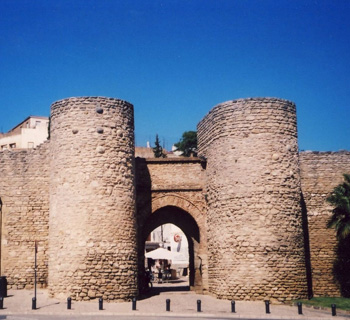
by Ana Ruiz
“Stay calm and don’t look out the window!” I say to myself on the uphill bus ride from Málaga to Ronda in Spain. The remarks of some nervous tourists and the high speed of the fearless bus driver do not help. Nevertheless, I gaze in awe at the precipitous drops and cliffs on the left side of my window. One of these roads (the A-397) is considered as one of the ‘black spots’ of Málaga roads with its 365 curves, although it is a favourite for daring motorcyclists.
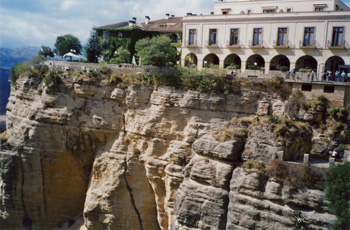 The sun is just setting behind the Serranía de Ronda (Ronda Mountain Range) and an hour and a half later, we arrive, relieved and unscathed.
The sun is just setting behind the Serranía de Ronda (Ronda Mountain Range) and an hour and a half later, we arrive, relieved and unscathed.
Situated in the province of Málaga, Ronda is celebrated for its spectacular mountainous scenery. Cliff-hanging houses perch upon a 400 foot gorge known as El Tajo (The Deep Cut) created by the Rio Guadalevín that flows through the center dividing the town in half. The river’s name is derived from the Arabic, Wadj al-Labin (River Valley of the Milk) because of the white bubbles and milky foam created by the streams and tributaries that gave it life. Something magical happens in Ronda when winds are so powerful that drops of water from the Guadalevín actually reach the bridge giving the appearance of raining upside down.
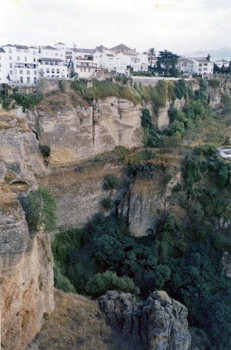 Ronda is one of the oldest cities in Spain first settled by the Celts around the 10th century BCE as Arunda. The town continued to thrive under the Romans as did the nearby settlement of Acinipo originally founded by the Phoenicians. Today, ruins of a vast Roman theatre and thermal baths dated to the 1st century can be visited about 12 miles northwest from Ronda in the ancient city of Acinipo or, as it is locally known, Ronda La Vieja (Old Ronda.)
Ronda is one of the oldest cities in Spain first settled by the Celts around the 10th century BCE as Arunda. The town continued to thrive under the Romans as did the nearby settlement of Acinipo originally founded by the Phoenicians. Today, ruins of a vast Roman theatre and thermal baths dated to the 1st century can be visited about 12 miles northwest from Ronda in the ancient city of Acinipo or, as it is locally known, Ronda La Vieja (Old Ronda.)
The Moors arrived at Arunda during the early 8th century and renamed it Hisn Arunda (Fortress of Arunda.) By the late 9th century, it was known as the Madinat Arunda (City of Arunda) and two centuries later functioned as an important capital of a Taifa (Moorish Kingdom.) Ruins from this once fortified town can still be appreciated today in the form of defensive wall vestiges and well-preserved gates dated to the 12th – 13th centuries. The most impressive are the fortified walls on the eastern part of the city known as La Cijara high up in the rocky plateau. The main entrance to the medina was through the triple-arched gate known as La Puerta de Almocábar. The name is derived from the Arabic, al-maqabir (the cemetery) as the gate was situated by the main burial grounds that stood outside the walled city.
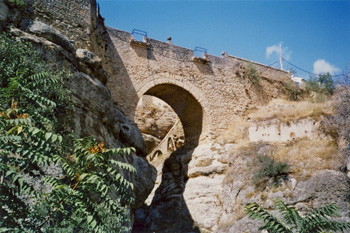 Ronda is the birthplace of the highly gifted 9th century Muslim Andalusí physician, mathematician, and engineer known as Abbas ibn Firnas. Of Berber descent, Firnas was also an illustrious inventor creating such ingenious devices as a water clock, a mechanized planetarium, an armillary sphere, and even a flying machine (for this reason, he is known as the “father of aviation.”) Firnas was also skilled in astronomy, music, and poetry as well as being responsible for introducing glass-making techniques to al-Andalus (Andalusia during Muslim Spain.) Today, he has an airport in northern Baghdad and a lunar crater named in his honour as well as a bridge in Córdoba where he died in 887.
Ronda is the birthplace of the highly gifted 9th century Muslim Andalusí physician, mathematician, and engineer known as Abbas ibn Firnas. Of Berber descent, Firnas was also an illustrious inventor creating such ingenious devices as a water clock, a mechanized planetarium, an armillary sphere, and even a flying machine (for this reason, he is known as the “father of aviation.”) Firnas was also skilled in astronomy, music, and poetry as well as being responsible for introducing glass-making techniques to al-Andalus (Andalusia during Muslim Spain.) Today, he has an airport in northern Baghdad and a lunar crater named in his honour as well as a bridge in Córdoba where he died in 887.
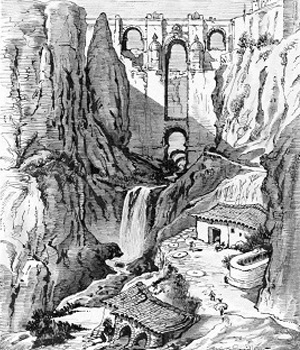 The town of Ronda is connected by three bridges that cross the deep canyon adding to the city’s remarkable features. The Roman Bridge is the oldest dating to the 11th century. Although it is Arabic in origin, it was likely constructed over an older Roman bridge. After the Christian conquest it was renamed Puente de San Miguel (St. Michaels Bridge.) Not far away is the early 17th century Puente Viejo (Old Bridge) and smallest of the three. As it was built over the ruins of an old Arab bridge, it is also known as Puente Árabe.
The town of Ronda is connected by three bridges that cross the deep canyon adding to the city’s remarkable features. The Roman Bridge is the oldest dating to the 11th century. Although it is Arabic in origin, it was likely constructed over an older Roman bridge. After the Christian conquest it was renamed Puente de San Miguel (St. Michaels Bridge.) Not far away is the early 17th century Puente Viejo (Old Bridge) and smallest of the three. As it was built over the ruins of an old Arab bridge, it is also known as Puente Árabe.
But the most impressive bridge is the striking Puente Nuevo (New Bridge.) This colossal architectural work, built during the second half of the 18th century, plunges over 300 feet into the canyon. From here you can also admire the incomparable views over the Serranía de Ronda Mountains and the picturesque white-washed houses overlooking the canyon.
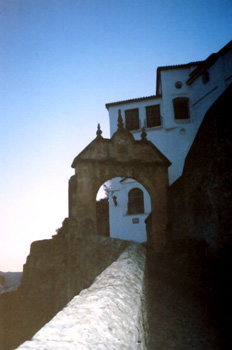 After crossing this bridge, I wander the charming old Moorish quarter with its winding pedestrian streets, white-washed houses, and historic squares. Locally known as La Ciudad (The City), the old quarter is situated on the south side of the gorge as opposed to the newer city on the north. Not for from Puente Nuevo in the historic quarter is an interesting gate known as Arco de Felipe V (Arch of Philip V.) This emblematic arch or gate, crowned by three pinnacles, was reconstructed in 1742 from the old Arab gate that provided access to the medina by the southwest.
After crossing this bridge, I wander the charming old Moorish quarter with its winding pedestrian streets, white-washed houses, and historic squares. Locally known as La Ciudad (The City), the old quarter is situated on the south side of the gorge as opposed to the newer city on the north. Not for from Puente Nuevo in the historic quarter is an interesting gate known as Arco de Felipe V (Arch of Philip V.) This emblematic arch or gate, crowned by three pinnacles, was reconstructed in 1742 from the old Arab gate that provided access to the medina by the southwest.
The first Moorish site on my itinerary is the 13th century Bańos Arabes (Arab Baths) located near the Arco de Felipe V. The public baths were traditionally situated outside the walled city where visitors, adhering to Muslim customs, cleansed and purified themselves before entering the city. Typical of this period, the Moorish architecture displayed the traditional Islamic-shaped supporting horseshoe arches and domed ceiling embellished with skylights in the shape of stars that magnificently illuminated the room. Used until the beginning of the 17th century, these Arab Baths are considered as the best preserved in the Iberian Peninsula and possibly Europe.
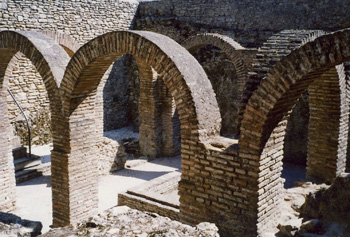 Next I decide to visit the 14th century Alminar (minaret) of San Sebastián in the old Moorish quarter. The impressive square tower is all that remains of a mosque that once stood here before it was destroyed and rebuilt by the Christians. The lower part is clearly Moorish in architecture while the top part was added by the Christians to house the bell tower of the San Sebastián Church that also once stood here.
Next I decide to visit the 14th century Alminar (minaret) of San Sebastián in the old Moorish quarter. The impressive square tower is all that remains of a mosque that once stood here before it was destroyed and rebuilt by the Christians. The lower part is clearly Moorish in architecture while the top part was added by the Christians to house the bell tower of the San Sebastián Church that also once stood here.
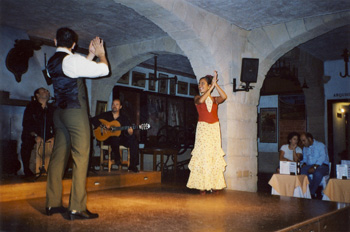 Near the minaret is the early 14th century Casa de Mondagrón that is also well worth visiting. The stone palace, promoted as “probably the most important civil monument in Ronda”, was the former residence of a king and its last Muslim governor. In 1485, Ronda was captured by the Christians and a few years later, King Fernando and Queen Isabella also made this palace their home. Although restored and enlarged during the 18th century, the exterior pales in comparison to the beauty of its interior adorned with arched patios, ceramic tiles, marble columns, balconies overlooking at inner courtyards, decorated fountains and water gardens. Today it also houses an auditorium and a municipal museum on the second floor.
Near the minaret is the early 14th century Casa de Mondagrón that is also well worth visiting. The stone palace, promoted as “probably the most important civil monument in Ronda”, was the former residence of a king and its last Muslim governor. In 1485, Ronda was captured by the Christians and a few years later, King Fernando and Queen Isabella also made this palace their home. Although restored and enlarged during the 18th century, the exterior pales in comparison to the beauty of its interior adorned with arched patios, ceramic tiles, marble columns, balconies overlooking at inner courtyards, decorated fountains and water gardens. Today it also houses an auditorium and a municipal museum on the second floor.
Ronda has its own particular palo (style of Flamenco song and guitar) that originated here during the early 19th century. This form, known as a Rondeńa, is considered to be the oldest of the fandangos of Málaga. For over 60 years Ronda has been home to one of the oldest Flamenco festivals in the province and one of the longest running in Andalusia that takes place every August.
 Ronda is also the birthplace of bullfighting. Not only was the first professional bullfighter born here in 1754 but it is also home of the oldest and largest bullfighting ring in the country dated to 1785. Another unique and unusual aspect of Ronda is their fascination with bandoleros (bandits); particularly those between the 18th and 19th centuries.
Ronda is also the birthplace of bullfighting. Not only was the first professional bullfighter born here in 1754 but it is also home of the oldest and largest bullfighting ring in the country dated to 1785. Another unique and unusual aspect of Ronda is their fascination with bandoleros (bandits); particularly those between the 18th and 19th centuries.
Bandits were numerous in this town as the surrounding, secluded mountainous landscape provided ample hidden spots from unsuspecting victims and the reach of authorities. These highway robbers and tobacco smugglers came to be regarded by the lower classes as heroes who took from the wealthy and gave to the poor. A few select have been elevated to legendary status. In the heart of the city stands the only museum in the country dedicated to the history and folklore of local bandits, Museo Del Bandolero (Museum of the Bandit.)
A solo traveler, I found plenty of fascinating sites to visit and explore all within walking distance. It is no wonder that Ronda is promoted as the “Ciudad Sońada” or “Dreamed City”.
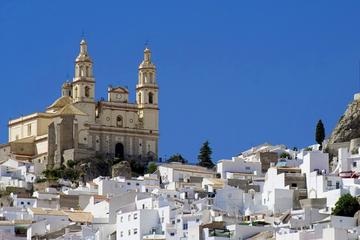
Ronda and White Villages Guided Day Tour from Seville
If You Go:
Málaga airport is the closest at 65 miles away. Ronda is easily accessible by bus or train from anywhere in the country. Prepare to do a lot of walking and bundle up in the winter as it can get cold near the mountains.
For more information in several languages visit: www.turismoderonda.es
About the author:
Ana Ruiz was born in Madrid and travels to Spain each spring. She currently resides in Montreal teaching dance and Spanish conversation classes. Ruiz has also worked as a journalist and columnist and is also the author of two books on Spanish history and culture; “Vibrant Andalusia” and “Medina Mayrit; the Origins of Madrid”. Visit: www.ana-ruiz.weebly.com
All photos by Ana Ruiz and artwork by her father, Manuel Ruiz:
Almocábar Gate
El Tajo
White-washed houses over cliff
Puente Viejo
“Puente Nuevo” by Manuel Ruiz (1950)
Arch of Philip V
Arab Baths
Flamenco at Museo Lara in the historic quarter
“Ronda” by Manuel Ruiz (1950)




